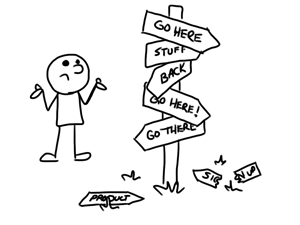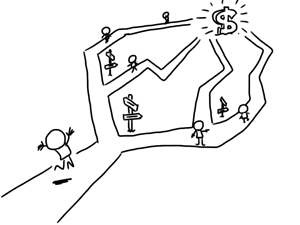Good content flow starts with great content. Whatever you are presenting to your users should be searchable meaning hefty doses of keywords in the content, headings, image alt tags, links, and even the file name.
Searchable content is the key because you know when visitors land on your page they are looking specifically for what your selling. Once you get them there your first priority is to start them down the path to a sale. This is what content that converts is all about.
Why should I write content that converts?
Content that converts should be the primary reason you are putting content on your site. What do you gain by putting random thoughts out there for all to read and marvel at? Only content that converts will help you reach your goal of driving visitors into your sales funnel.
Without content that converts you put your visitors on a path of confusion. Nothing frustrates a site visitor more than broken navigation and misleading links.
 First, let’s talk about broken navigation and links. Nothing says amateur like a broken link in your main menu. If you cross-link content everywhere you are going to have broken links. There’s just no way to keep track of all of them especially if you’re linking to other websites. Try to keep your links specific to the topic of the post.
First, let’s talk about broken navigation and links. Nothing says amateur like a broken link in your main menu. If you cross-link content everywhere you are going to have broken links. There’s just no way to keep track of all of them especially if you’re linking to other websites. Try to keep your links specific to the topic of the post.
What are misleading links? Here’s an example: I click on a link that says “5 tips to better content” and it takes me to a page about your book on writing content. Give me my 5 tips and THEN I’ll consider looking at your book. This is how a sales funnel works. It’s a funnel; not a trap door.
Content that converts leads a visitor toward a goal
 Unless you run a news or magazine site where the only goal is to share sponsored content you can have a “wall of links” to sponsored content and you’re done. Visitors get content and sponsors get exposure. But if your site has one specific goal then every path should lead to that goal.
Unless you run a news or magazine site where the only goal is to share sponsored content you can have a “wall of links” to sponsored content and you’re done. Visitors get content and sponsors get exposure. But if your site has one specific goal then every path should lead to that goal.
Guiding your visitors towards a goal requires that you give them proper directions. Every link on your landing page should either lead directly to your primary or secondary goal or lead to a page that will convince your visitor that whatever you are selling is what they need.
I hope you’re starting to see a pattern here. If not, the point I’m trying to make is to lead your visitors to your goals. It’s the only way to get them where you want them to go.
